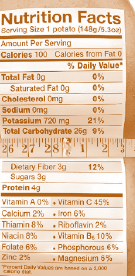Weeds – The easiest weed control in the home garden is hoeing, pulling and/or light cultivation before vines reach 8 to 10 inches in height. Avoid cultivation beyond this stage as damage to roots, stolons and developing tubers may occur, resulting in yield loss. Potato plants are better able to compete with weeds at this stage, reducing the need for much additional weed control. The most common weeds in the home garden include red root pigweed, kochia, lambsquarters and occasionally nightshade. If you find quackgrass or Canada thistle, contact your local Extension agent or garden supply store for control information.
Diseases – Potato diseases may be seed-borne, soil-borne or acquired during the growing season. To avoid many of them, purchase certified seed potatoes. Promptly remove any plants that are small, yellowing or sickly. The most common diseases in the home garden include common scab, early or late blight, pink rot and black scurf. They are summarized in Table 2.
Table 2. Common potato diseases in the home garden.*| Disease | Symptoms | Control | Other notes |
|---|
| * Occurrence in your garden will depend on environmental conditions, your production practices and the presence of pathogens in your garden or on nearby bedding plants. |
Common scab Streptomyces scabies | Small brown lesions on the tuber surface. | Long crop rotation. | Cosmetic disease; does not affect tuber quality typically. Observed at harvest; seen most frequently if dry conditions, in soils high in organic matter or those with recent manure applications. |
Early blight
Alternaria solani | Targetlike lesions beginning on the lower, maturing leaves of potato plants. | Prevent stress and maintain proper fertility and soil moisture levels. Fungicide treatments control the disease. | Tubers still are edible. |
Late blight
Phytophthora infestans | Dark green, almost greasy, watery lesions on the leaves; may have a light green to yellow “halo” around the lesion on the upper surface. The underside may have white fungal growth rimming the lesion. | Preventative fungicide treatments are the only option. No control is available once blight attacks due to virulent strains of the fungus. Promptly remove diseased plants or kill the entire plot. | Tuber rot is characterized by mahogany discoloration to tuber surfaces and flesh; tubers may break down due to subsequent invasion by other rotting organisms. |
Pink rot
Phytophthora erythrosceptica | Swollen, waterlogged tubers that may be partially or totally rotted. If cut or broken open, tuber flesh turns salmon pink within 30 minutes. | Proper water management, particularly late in the growing season. | Referred to as a water rot; occurs when plants have been overwatered. |
Black scurf
Rhizoctonia solani | Small, irregular black patches on the tuber skin that won’t wash off. | Purchase and plant disease-free seed. | A cosmetic disease. |
Insects – Common insects in the home garden affecting potatoes may include aphids, flea beetles, Colorado potato beetles, wireworms and grubs. Most can be treated with insecticides, or insecticidal soaps for those preferring organic methods. You also can remove the Colorado potato beetles by hand if the garden area is small.

